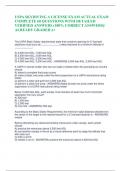USPA SKYDIVING A LICENSE EXAM ACTUAL EXAM
COMPLETE 60 QUESTIONS WITH DETAILED
VERIFIED ANSWERS (100% CORRECT ANSWERS)/
ALREADY GRADED A+
The USPA Basic Safety requirements state that container opening for C-licensed
skydivers must occur by _____________ unless waivered to a minimum altitude of
_____________:
A) 2,000 feet AGL, 1,500 feet AGL
B) 2,500 feet AGL, 2,000 feet AGL
C) 3,000 feet AGL, 2,500 feet AGL
D) 4,000 feet AGL, 3,500 feet AGL - ANSWERB) 2,500 feet AGL, 2,000 feet AGL
A USPA C-license holder who has not made a freefall within the preceding six months
should:
A) attend a complete first-jump course
B) make at least one jump under the direct supervision of a USPA instructional rating
holder
C) perform a clear-and-pull from 3,000 feet AGL
D) perform a static-line jump - ANSWERB) Make at least one jump under the direct
supervision of a USPA instructional rating holder
Below 10,000 feet AGL, each jumper must maintain at least how much horizontal
separation from any cloud?
A) 500 feet
B) 1,000 feet
C) 2,000 feet
D) one mile - ANSWERA) 500 feet
According to the Basic Safety Requirements, the minimum radial distance allowed from
the center of the target to the nearest hazard for a C licensed skydiver is - ANSWER50
meters
Before attempting any advanced landing maneuvers under canopy, each jumper
should:
A) practice the maneuver above 2,500 feet AGL
B) use another canopy in the air as a visual reference point to judge the altitude loss
with each turn
C) both a and b
D) neither a nor b - ANSWERA) practice the maneuver above 2,500 feet AGL
, When choosing to jump a smaller canopy, jumpers should be familiar with (on their
previous canopy):
A) flaring for landing from slow flight
B) consistent soft, stand-up landings within 10 meters of a planned target in a variety of
wind conditions
C) beginning to flare, turning to 10 degree bank, and returning to a level wing before
landing
D) all of the above - ANSWERD) all of the above
According to SIM Section 6-10, any parachute smaller than 150 square feet:
A) is considered advanced regardless of wing loading
B) is considered advanced only if above a 0.9:1 wing loading
C) is considered advanced only if above a 1.1:1 wing loading
D) is considered advanced only if above a 1.3:1 wing loading - ANSWERA) is
considered advanced regardless of wing loading
With aircraft flown into the wind for jump run, which exit order provides the best chance
for maintaining adequate horizontal separation between each group of jumpers?
A) faster falling groups exit first, followed by slower falling groups, wingsuiters, then
tandems
B) slower falling groups exit first, followed by faster falling groups, tandems, then
wingsuiters
C) wingsuiters exit first, followed by faster falling groups, slower falling groups, then
tandems
D) tandems exit first, followed by faster falling groups, slower falling groups, then
wingsuiters - ANSWERB) slower falling groups exit first, followed by faster falling
groups, tandems, then wingsuiters
Seat belts in an aircraft used for skydiving operations:
A) are required for jumpers only for take-off
B) may be from previous use in automobiles
C) should never be fastened together unless being worn
D) are only required to be used by pilots - ANSWERare required for jumpers only for
take-off
For high-altitude skydives (above 25,000 feet MSL), each jumper should breathe 100
percent pure oxygen:
A) beginning 10 minutes prior to takeoff
B) beginning at exit from the aircraft
C) mixed with 10 percent nitrogen
D) beginning 30 minutes prior to takeoff - ANSWERD) beginning 30 minutes prior to
takeoff
A demonstration jump into a stadium would require which of the following as the
minimum qualification?
A) USPA C license




